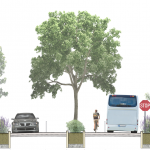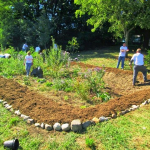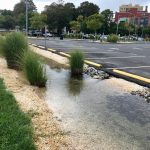New Jersey Future Blog
Want to Get Ahead of Flooding? Use NJF’s New Tool, the Enhanced Model Stormwater Ordinance
February 9th, 2021 by Andrew Tabas
Stormy days ahead call for strong municipal stormwater ordinances. Climate change is bringing increased rainfall and flooding to New Jersey which, if ignored, will damage property, threaten public health, and pollute waterways. Municipal governments’ responses to this challenge will define the quality of life in their towns for generations. Fortunately, municipalities have a strong device to promote responsible and resilient development: stormwater ordinances. The stormwater ordinance is key to implementing public and private green infrastructure, a group of practices that mimic the natural water cycle to capture rainwater where it falls. Municipal leaders should use New Jersey Future’s new tool to update their town’s stormwater ordinance as soon as possible to increase green infrastructure and reduce flood risk.
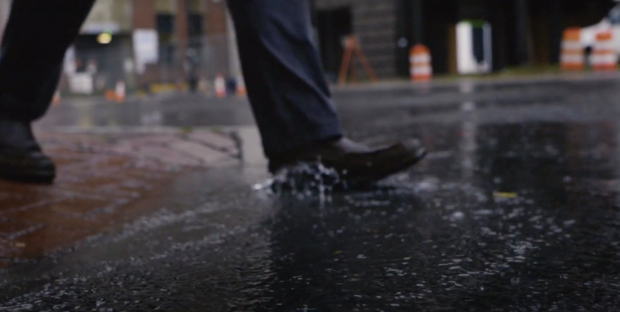
To prevent flooding in the face of increased rainfall from climate change, municipal leaders should use NJF’s Enhanced Model Stormwater Ordinance to develop their local stormwater ordinance.
With the state’s most recent amendments (effective March 2) now requiring stormwater to be managed with green infrastructure (GI), each municipality can decide how best to bring the benefits of GI to their communities with an enhanced ordinance that is stronger than the state’s minimum requirements.
To help municipalities make choices about how to adopt a stronger stormwater ordinance, New Jersey Future developed a new tool, the Enhanced Model Stormwater Ordinance for Municipalities, also available as an editable Word document. It compares and recommends several options for improvements to the minimum requirements in NJDEP’s example stormwater ordinance. While NJDEP’s requirements represent a paradigm shift in stormwater management, municipalities that want to get ahead of flooding and climate change, improve water quality in local waterways, and encourage developers to use more GI in their projects should consider going further. Municipalities can use their stormwater ordinance to partner with developers of both public and private projects to build GI, multiplying its benefits.
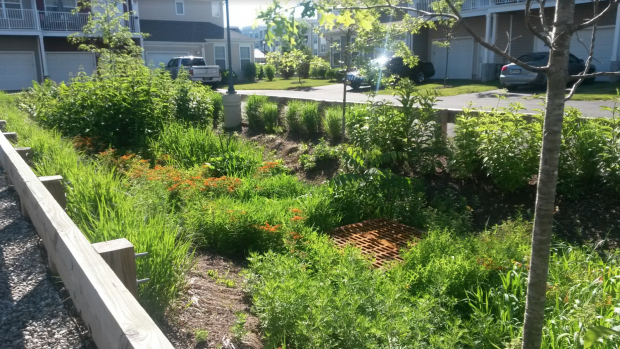
Green infrastructure, like this bioswale in Somerset, New Jersey, captures rainwater and reduces flood risk. Towns can use their stormwater ordinances to require green infrastructure. Source: Maser Consulting, 2020.
This new tool—a menu of options for towns—offers several ways for municipalities to go above and beyond DEP’s requirements, including:
- Redefine the threshold for “major development.” Reducing the threshold to trigger management of stormwater for major developments will include more development projects, capturing more stormwater. Towns that are more dense may wish to use even smaller thresholds.
- Add a definition and requirements for “minor development.” This will require additional, smaller sites to use GI. The requirements for minor development are less stringent than the requirements for major development.
- Require stormwater management on existing impervious surfaces, not just new. To add a requirement for GI in redevelopment projects, municipalities can expand the definition of “regulated impervious surface” to include “all impervious surface within the project area” instead of the “net increase of impervious surface.” Regulating existing impervious surfaces includes redevelopment sites, which will address longstanding runoff issues from existing development. Not taking this step will allow historical polluted runoff to continue to exist.
- Require infiltration of a specific volume of stormwater onsite. Requiring the infiltration of a specific volume of stormwater will increase the amount of clean stormwater returned to the ground and reduce runoff. Decreased runoff will lower the flood risk from frequent, small storms.
- Reduce “maximum contributory drainage areas.” Each GI best management practice (BMP), such as a rain garden or pervious pavement, is designed to receive stormwater runoff from a specified area. Reducing the drainage area for each BMP will prevent the BMPs from becoming overloaded and will increase the number of BMPs used in each development.
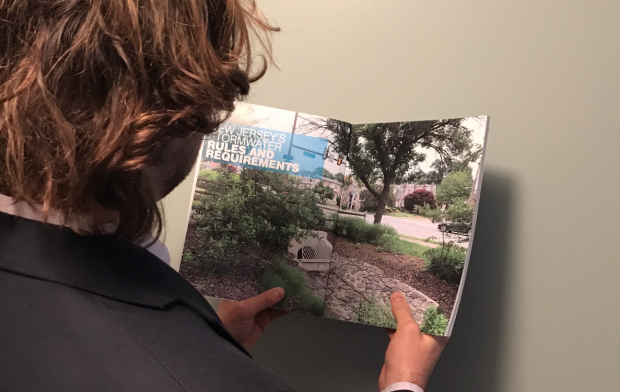 Understanding New Jersey’s rules and requirements and the opportunities for going above and beyond can help municipal leaders to build a safe, healthy, and resilient town. Photo credit: Andrew Tabas.
Understanding New Jersey’s rules and requirements and the opportunities for going above and beyond can help municipal leaders to build a safe, healthy, and resilient town. Photo credit: Andrew Tabas.
Ordinance enhancements in 2021 will dovetail with NJDEP’s plan for future regulatory amendments to address climate change later this year. By writing their updated stormwater ordinances with purpose, local leaders can put their towns on the path to managing flood risk and to being greener, more attractive, and safer places. For additional information on how to implement GI, municipal leaders should consult the Green Infrastructure Municipal Toolkit and the Developers Green Infrastructure Guide. The result of these efforts by each town in New Jersey will be a thriving state whose streets are tree-lined, whose waterways are clean, and whose people are happy and healthy.
For questions about New Jersey Future’s Enhanced Model Stormwater Ordinance for Municipalities, contact Kandyce Perry (kperry njfuture
njfuture org) .
org) .
Related Posts
Tags: combined sewer system, enhanced model stormwater ordinance for municipalities, GI, green infrastructure, Municipal Toolkit, njdep, Stormwater

